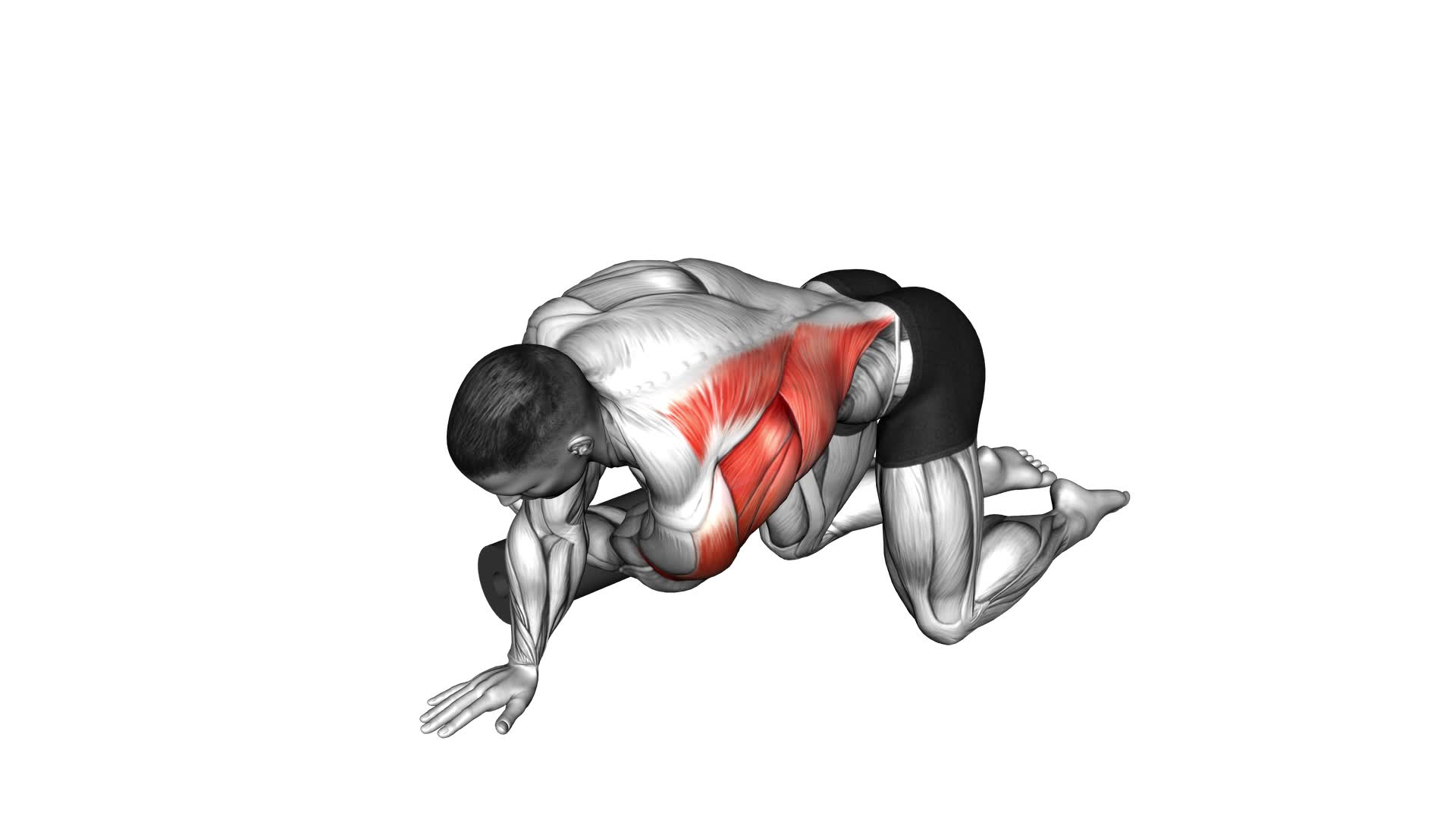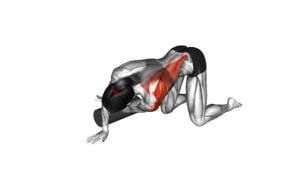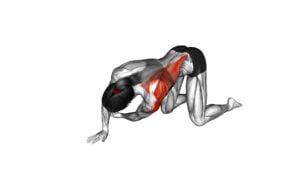Roll Kneeling Upper Back Rotation – Video Exercise Guide & Tips

Are you looking for a quick and effective way to improve your upper back mobility? Look no further than the Roll Kneeling Upper Back Rotation exercise!
Watch This Exercise Video
In this video exercise guide, we'll show you the proper form and technique to get the most out of this movement.
With just a few minutes a day, you can enhance your flexibility and strengthen your back muscles.
Get ready to roll and transform your workout routine today!
Key Takeaways
- Improved flexibility in the upper back
- Increased range of motion in the upper back
- Enhanced spinal mobility
- Increased core stability
Benefits of Roll Kneeling Upper Back Rotation
The benefits of roll kneeling upper back rotation include improved flexibility and increased range of motion in your upper back. This exercise is designed to enhance your spinal mobility and increase your core stability. By incorporating roll kneeling upper back rotation into your routine, you can experience numerous advantages.
Firstly, this exercise improves your spinal mobility. As you rotate your upper back, you engage the muscles along your spine, promoting better movement and flexibility. This increased mobility can alleviate stiffness and discomfort, allowing for smoother daily activities.
Secondly, roll kneeling upper back rotation helps to increase your core stability. As you rotate, you engage your core muscles, including your abdominals and obliques. These muscles play a crucial role in providing support and stability to your spine. By strengthening your core, you can improve your posture, reduce the risk of injuries, and enhance your overall strength.
Incorporating roll kneeling upper back rotation into your exercise routine can have significant benefits for your upper back flexibility, spinal mobility, and core stability. By practicing this exercise regularly, you can enjoy increased range of motion, improved posture, and a stronger core.
Proper Form and Technique
To perform the roll kneeling upper back rotation exercise with proper form and technique, follow these steps:
- Start by kneeling on a mat or soft surface, with your knees hip-width apart and your toes pointed.
- Place your hands on your thighs, keeping your spine in a neutral position.
- Engage your core muscles to stabilize your torso.
- Inhale deeply and as you exhale, slowly roll your upper back down towards the mat, one vertebra at a time.
- Keep your neck long and relaxed throughout the movement.
- Once your upper back is on the mat, inhale and rotate your upper body to one side, keeping your hips and lower body stable.
- Exhale and return to the starting position.
- Repeat on the other side.
Now, let's address some common misconceptions about this exercise.
One misconception is that you need to roll all the way down to your lower back. However, the focus of this exercise is on the upper back rotation, so you only need to roll down until your upper back is on the mat.
Another misconception is that you need to rotate your neck as well. It's important to keep your neck relaxed and in a neutral position throughout the exercise to avoid straining the neck muscles.
There are also variations and alternatives to the roll kneeling upper back rotation exercise.
One variation is to use a foam roller or a yoga block under your upper back for added support. This can be helpful if you have limited mobility or want to modify the exercise.
Another alternative is to perform the exercise in a seated position, with your legs extended in front of you. This can be a good option if kneeling is uncomfortable or not feasible for you.
Remember to always listen to your body and choose the variation or alternative that works best for you.
Equipment Needed for the Exercise
To properly perform the roll kneeling upper back rotation exercise, you'll need some equipment. Here are the three items you'll need:
- Resistance bands: These elastic bands provide resistance during the exercise, helping to strengthen your upper back muscles. Choose a band with the appropriate resistance level for your fitness level.
- Stability ball: Also known as an exercise ball or Swiss ball, a stability ball is used as a prop for this exercise. The ball adds instability, engaging your core muscles and challenging your balance as you perform the rotations.
- Yoga mat: While not essential, a yoga mat can provide added comfort and support when performing the exercise. It can also help prevent slipping or sliding during the movements.
Make sure to have these items ready before you start the exercise. Set up your stability ball on a flat surface and place your yoga mat underneath for added cushioning. Secure the resistance band in a way that allows you to comfortably hold onto it during the rotations.
Having the right equipment will ensure that you can perform the roll kneeling upper back rotation exercise effectively and safely.
Modifications and Progressions
Try incorporating different variations of the roll kneeling upper back rotation to challenge your muscles and progress your workout.
If you're looking for alternative exercises, you can try the seated twist or the standing torso twist. These exercises target the same muscle groups as the roll kneeling upper back rotation but provide a different range of motion. The seated twist can be done on a chair or a stability ball, while the standing torso twist can be performed with or without weights. Both exercises engage the upper back and core muscles, helping to improve posture and increase rotational strength.
For those who want to take their workout to the next level, there are advanced variations of the roll kneeling upper back rotation. One option is to add resistance by holding a dumbbell or a medicine ball while performing the exercise. This increases the challenge on your muscles and can help build strength and stability. Another advanced variation is to perform the exercise on an unstable surface, such as a balance disc or a BOSU ball. This adds an additional element of balance and stability, requiring your muscles to work even harder.
Remember to always listen to your body and progress at your own pace. Start with the basic version of the roll kneeling upper back rotation and gradually incorporate the alternative exercises and advanced variations as you feel comfortable and confident.
Common Mistakes to Avoid
Be mindful of these common mistakes when performing the roll kneeling upper back rotation exercise. To ensure that you get the most out of this exercise and avoid injury, here are three common errors to watch out for and how to correct them:
- Twisting from the hips: One common mistake is to initiate the rotation from the hips rather than the upper back. This not only reduces the effectiveness of the exercise but also puts unnecessary strain on the lower back. To correct this, focus on keeping your hips stable and initiating the movement from your upper back.
- Overarching the lower back: Another mistake is to arch the lower back excessively during the rotation. This can lead to discomfort and potential injury. To fix this, engage your core muscles and maintain a neutral spine throughout the movement. Imagine a straight line from your head to your tailbone.
- Rushing the movement: Many people tend to rush through the exercise, sacrificing proper form. This not only reduces the benefits of the exercise but also increases the risk of injury. Take your time and perform the movement slowly and controlled. Focus on maintaining proper alignment and feeling the muscles working.
Tips for Maximizing the Exercise's Effectiveness
Continue building on your progress and enhance the effectiveness of the roll kneeling upper back rotation exercise by incorporating these tips.
Proper breathing and engaging your core muscles are essential for maximizing the benefits of this exercise.
Firstly, focus on your breathing technique. Take deep breaths in through your nose, and as you rotate your upper back, exhale through your mouth. This controlled breathing pattern helps to oxygenate your muscles and maintain stability throughout the movement.
Next, engage your core muscles throughout the exercise. Imagine pulling your belly button towards your spine to activate your deep core muscles. This not only provides stability but also helps to protect your lower back.
Additionally, be mindful of your posture. Keep your spine neutral and maintain a tall posture throughout the exercise. Avoid slouching or rounding your shoulders, as this can limit the range of motion and reduce the effectiveness of the exercise.
Lastly, start with lighter weights or no weights at all and gradually increase the resistance as you build strength and stability. It's important to maintain proper form and control throughout the movement, even as you progress to heavier weights.
Frequently Asked Questions
Is the Roll Kneeling Upper Back Rotation Suitable for Beginners?
Yes, the roll kneeling upper back rotation can be suitable for beginners. If you're just starting out, there are modifications you can make to make it easier. You can use a smaller range of motion or go slower in the movement.
Additionally, there are alternative exercises you can try, such as seated thoracic rotations or cat-cow stretches, which can help you build strength and flexibility in your upper back.
Can the Roll Kneeling Upper Back Rotation Help With Posture Correction?
The roll kneeling upper back rotation is a great exercise for improving posture. By incorporating this move into your daily workout routine, you can reap the benefits of better overall fitness.
This exercise targets the muscles in your upper back, helping to strengthen and mobilize them. To perform it, simply follow the instructions in the video guide. Remember to start slowly and gradually increase the intensity as you become more comfortable.
With consistency, you'll notice improvements in your posture and overall fitness.
How Often Should the Roll Kneeling Upper Back Rotation Be Performed for Optimal Results?
For optimal results, perform the roll kneeling upper back rotation regularly. This exercise is beneficial for improving your posture and strengthening your upper back.
To get the most out of it, aim to do it at least 2-3 times a week. Consistency is key, so try to incorporate it into your fitness routine.
Remember to listen to your body and start with a comfortable range of motion, gradually increasing as you get stronger.
Are There Any Potential Risks or Injuries Associated With the Roll Kneeling Upper Back Rotation?
When performing the roll kneeling upper back rotation, it's important to be aware of the potential risks and take necessary precautions.
This exercise involves twisting and rotating your upper back, which can put strain on your spine if not done correctly.
To avoid injury, make sure to maintain proper form, engage your core muscles, and start with a lower range of motion.
If you have any existing back or neck issues, it's best to consult with a professional before attempting this exercise.
Can the Roll Kneeling Upper Back Rotation Be Done Without Any Equipment?
Yes, you can do the roll kneeling upper back rotation without any equipment. This exercise targets your upper back and can be done using just your bodyweight.
It's a great alternative to using equipment and provides numerous benefits. Upper back rotation exercises like this one can improve spinal mobility, increase flexibility, and strengthen your back muscles.
Incorporating this exercise into your routine can help you achieve a stronger and more flexible upper back.
Conclusion
To maximize the effectiveness of the roll kneeling upper back rotation exercise, it's important to maintain proper form and technique. This exercise helps improve flexibility and mobility in the upper back, promoting better posture and reducing the risk of injury.
Remember to start with lighter weights and gradually increase the intensity as you become more comfortable. Avoid common mistakes like rounding the shoulders or using momentum to complete the movement.
With consistent practice and attention to detail, you can reap the benefits of this exercise.

Author
Years ago, the spark of my life’s passion ignited in my mind the moment I stepped into the local gym for the first time. The inaugural bead of perspiration, the initial endeavor, the very first surge of endorphins, and a sense of pride that washed over me post-workout marked the beginning of my deep-seated interest in strength sports, fitness, and sports nutrition. This very curiosity blossomed rapidly into a profound fascination, propelling me to earn a Master’s degree in Physical Education from the Academy of Physical Education in Krakow, followed by a Sports Manager diploma from the Jagiellonian University. My journey of growth led me to gain more specialized qualifications, such as being a certified personal trainer with a focus on sports dietetics, a lifeguard, and an instructor for wellness and corrective gymnastics. Theoretical knowledge paired seamlessly with practical experience, reinforcing my belief that the transformation of individuals under my guidance was also a reflection of my personal growth. This belief holds true even today. Each day, I strive to push the boundaries and explore new realms. These realms gently elevate me to greater heights. The unique combination of passion for my field and the continuous quest for growth fuels my drive to break new ground.







